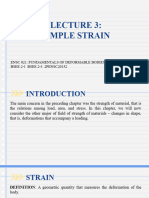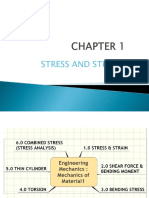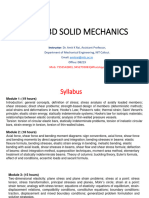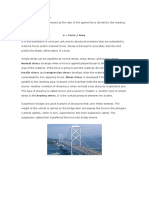Chapter 04 Axial Load
Uploaded by
Sumaya MahmoodChapter 04 Axial Load
Uploaded by
Sumaya MahmoodSaintVenant'sPrinciple :
Thestrainandstresswillevenoutandbecomeuniformoverthecrosssectionlocatedatposition
beingatleastequaltothelargestdimensionofthecrosssection.
Stressandstrainproducedatpointsinabody
sufficientlyremovedfromtheregionofload
applicationwillbethesameasthestressandstrain
producedbyanyappliedloadingsthathavethe
samestaticallyequivalentresultant,andareapplied
tothebodywithinthesameregion.
ElasticDeformationofanAxiallyLoadedMember
Assumenegligiblelocalizeddeformation,calculatetherelativedisplacementbetweenthetwoends
Iftheexternalloadforce,crosssectionareaandEareconstant:
Ifthebarissubjectedtoseveraldifferentaxialforces:
Ingeneral,deformationofanaxiallyloadedbariso = ]
1
L
P(x)
A(x)
Jx
x=L
x=0
Chapter4AxialLoad
Chapter 4 Axial Load Page 1
Example4.1
TheassemblyshownconsistsofanaluminumtubeABhavinga
crosssectionalareaof4uu mm
2
.Asteelrodhavingadiameterof
1u mm isattachedtoarigidcollarandpassesthroughthetube.If
atensileloadof8u kN isappliedtotherod,determinethe
displacementoftheendCoftherod.TakeE
st
= 2uu 0Po,
E
uI
= 7u 0Po.
Example4.2(Ex4.3)
Amemberismadefromamaterialthathasaspecificweighty and
modulusofelasticityE.ifitisintheformofaconehavingthedimensionas
shown,determinehowfaritsendisdisplacedduetogravitywhenitis
suspendedintheverticalposition.
Examples
Chapter 4 Axial Load Page 2
Bysubdividingtheloadingintocomponents,theprincipleofsuperpositionstatesthattheresultantstressor
displacementatthepointcanbedeterminedbyalgebraicallysummingthestressordisplacementcausedbyeachload
componentappliedseparatelytothemember.
Twoconditions needtobesatisfiedforapplyingtheprinciple:
Theloadingmustbelinearlyrelatedtothestressordisplacementthatistobedetermined 1.
Theloadingmustnotsignificantlychangetheoriginalgeometryorconfigurationofthemember 2.
Superposition: Linearproblem Smalldeflections
PrincipleofSuperposition
Chapter 4 Axial Load Page 3
Considerthebar
equilibriumequationisnotsufficienttodeterminethetworeactions staticallyindeterminate problem
Needtoconsiderhowpointsonthebardisplace.
Equationthatspecifiestheconditionsfordisplacement acompatibilityorkineticcondition
Theindeterminateproblemcanalsobesolvedbywritingthecompatibilityequationusingtheprinciple
ofsuperposition flexibilityorforcemethodofanalysis.
Example4.3(Ex4.6)
ThethreeA992barsarepinconnectedtoarigidmember.Iftheappliedloadonthememberis15kN,
determinetheforcedevelopedineachbar.BarsABandEFeachhaveacrosssectionalareaofSu mm
2
,
andbarCDhasacrosssectionalareaofSu mm
2
.
Staticallyindeterminateproblem
FBD Equationsofequilibrium
Equationsofcompatibility(usingdisplacementscausedbyloading)
StaticallyIndeterminateAxiallyLoadedMember
Chapter 4 Axial Load Page 4
Formostofmaterials,temperatureincreases(decrease)cancauseabodyexpansion(contraction)indimension
thermalexpansion.
Inalargerangeoftemperature,thechangeindimensionsislinearlyrelatedtothechangeintemperature
o
1
= oII
Whenthechangeisconstrained(staticallyindeterminate),stresswillbegeneratedwithinthebody
Example4.4(ex4.9)
TheA36steelbarasshownisconstrainedtojustfitbetweentwofixedsupportswhenI
1
= 6uF,
determinetheaveragenormalthermalstressdevelopedinthebar.
ThermalStress
Chapter 4 Axial Load Page 5
Themaximumnormalstressoccursatthesmallestcrosssectionalarea
Ifthedeformationislinearelastic:thestressdistributioncanbedeterminedbymathematicalanalysisor
experimentally
StressConcentrationFactor
ForceEquilibrium AverageStress
StressConcentrationFactorK =
c
mcx
c
min
StressConcentrations
Chapter 4 Axial Load Page 6
You might also like
- 6.1 Flexural Analysis (Uncraked Beam Section)No ratings yet6.1 Flexural Analysis (Uncraked Beam Section)30 pages
- Verification of Bending Stress and Shear Stress Distribution Across The Depth For Slender BeamNo ratings yetVerification of Bending Stress and Shear Stress Distribution Across The Depth For Slender Beam6 pages
- Verification of Bending Stress and Shear Stress Distribution Across The Depth For Slender BeamNo ratings yetVerification of Bending Stress and Shear Stress Distribution Across The Depth For Slender Beam7 pages
- Lecture3 Axial Deformation Statically Indeterminate MembersNo ratings yetLecture3 Axial Deformation Statically Indeterminate Members22 pages
- Flexural Stresses or Bending Stresses in Beams (Derivation of Bending Stress Equation)No ratings yetFlexural Stresses or Bending Stresses in Beams (Derivation of Bending Stress Equation)3 pages
- Lesson 3 - Simple Strain - For PresentationNo ratings yetLesson 3 - Simple Strain - For Presentation33 pages
- Strength of Materials/Mechanics of Deformable Bodies - 1No ratings yetStrength of Materials/Mechanics of Deformable Bodies - 110 pages
- Mechanics of Solids - II (: CE-205) FALL 2016No ratings yetMechanics of Solids - II (: CE-205) FALL 201620 pages
- Tension. The Forces On The Rope Are The Wight of The Load Acting Downwards andNo ratings yetTension. The Forces On The Rope Are The Wight of The Load Acting Downwards and3 pages
- 06 Deformation in A System of Axially Loaded Members StudentsNo ratings yet06 Deformation in A System of Axially Loaded Members Students5 pages
- Unit-I Thin Plate Theory, Structural InstabilityNo ratings yetUnit-I Thin Plate Theory, Structural Instability78 pages
- Lecture 2-Normal Stress Under Axial Loading PDFNo ratings yetLecture 2-Normal Stress Under Axial Loading PDF12 pages
- Module-1-Stress-Strain-Relationship (1)No ratings yetModule-1-Stress-Strain-Relationship (1)54 pages
- WK 1. Mechanics of Materials and StressNo ratings yetWK 1. Mechanics of Materials and Stress14 pages
- Theory of Elastisity, Stability and Dynamics of Structures Common ProblemsFrom EverandTheory of Elastisity, Stability and Dynamics of Structures Common ProblemsNo ratings yet
- Instructions on Modern American Bridge BuildingFrom EverandInstructions on Modern American Bridge BuildingNo ratings yet
- Chapter 6 Bending: Moments Forces Perpendicular To AxisNo ratings yetChapter 6 Bending: Moments Forces Perpendicular To Axis13 pages
- Wireless Statement: $105.25 Amount To Be DebitedNo ratings yetWireless Statement: $105.25 Amount To Be Debited14 pages
- Chapter 2 Strain: Deformation: Change in Shape And/or Size of The Body Under A ForceNo ratings yetChapter 2 Strain: Deformation: Change in Shape And/or Size of The Body Under A Force5 pages
- 4130 Alloy Steel (Available in Round, Sheet, Tube)No ratings yet4130 Alloy Steel (Available in Round, Sheet, Tube)2 pages
- Secondary Application Form Fall 2013 Entering Class: Mahmood MadihaNo ratings yetSecondary Application Form Fall 2013 Entering Class: Mahmood Madiha2 pages
- Plenum Support Stiffeners-Detail 2 - 10thkNo ratings yetPlenum Support Stiffeners-Detail 2 - 10thk22 pages
- Member Design - Reinforced Concrete Beam BS81100% (1)Member Design - Reinforced Concrete Beam BS811035 pages
- Institute of Aeronautical Engineering: Dundigal, Hyderabad - 500 043No ratings yetInstitute of Aeronautical Engineering: Dundigal, Hyderabad - 500 043169 pages
- Endogenic - Rocks, Stress, and DeformationNo ratings yetEndogenic - Rocks, Stress, and Deformation23 pages
- Basic Concept of Base Isolation System For BuildingsNo ratings yetBasic Concept of Base Isolation System For Buildings23 pages
- Mechanical Testing Methods of Fibres and CompositesNo ratings yetMechanical Testing Methods of Fibres and Composites4 pages
- Slender Column Test For Different End CondNo ratings yetSlender Column Test For Different End Cond4 pages
- Engineering Fracture Mechanics: SciencedirectNo ratings yetEngineering Fracture Mechanics: Sciencedirect14 pages
- Probabilistic Seismic Hazard Macrozonation in Sri LankaNo ratings yetProbabilistic Seismic Hazard Macrozonation in Sri Lanka14 pages
- «1» sheet of calculation (explanatory note) see file 1115COТ 625190RR - 01.dwgNo ratings yet«1» sheet of calculation (explanatory note) see file 1115COТ 625190RR - 01.dwg18 pages
- A Case Study Delhi Metro Phase III Balanced Cantilever Bridge PDFNo ratings yetA Case Study Delhi Metro Phase III Balanced Cantilever Bridge PDF54 pages
- Rabin Lamsal Et Al. Be Civil Project May 2023No ratings yetRabin Lamsal Et Al. Be Civil Project May 2023169 pages
- Slope Stability Analysis by Shear Strength Reduction Method: J C E UNo ratings yetSlope Stability Analysis by Shear Strength Reduction Method: J C E U3 pages
- Nonlinear Continuum Mechanics for Finite Elasticity-Plasticity: Multiplicative Decomposition with Subloading Surface Model 1st Edition Koichi Hashiguchi 2024 Scribd Download100% (5)Nonlinear Continuum Mechanics for Finite Elasticity-Plasticity: Multiplicative Decomposition with Subloading Surface Model 1st Edition Koichi Hashiguchi 2024 Scribd Download66 pages
- Elements in Machine Design (J.T.) Module 6No ratings yetElements in Machine Design (J.T.) Module 66 pages
- Verification of Bending Stress and Shear Stress Distribution Across The Depth For Slender BeamVerification of Bending Stress and Shear Stress Distribution Across The Depth For Slender Beam
- Verification of Bending Stress and Shear Stress Distribution Across The Depth For Slender BeamVerification of Bending Stress and Shear Stress Distribution Across The Depth For Slender Beam
- Lecture3 Axial Deformation Statically Indeterminate MembersLecture3 Axial Deformation Statically Indeterminate Members
- Flexural Stresses or Bending Stresses in Beams (Derivation of Bending Stress Equation)Flexural Stresses or Bending Stresses in Beams (Derivation of Bending Stress Equation)
- Strength of Materials/Mechanics of Deformable Bodies - 1Strength of Materials/Mechanics of Deformable Bodies - 1
- Tension. The Forces On The Rope Are The Wight of The Load Acting Downwards andTension. The Forces On The Rope Are The Wight of The Load Acting Downwards and
- 06 Deformation in A System of Axially Loaded Members Students06 Deformation in A System of Axially Loaded Members Students
- Theory of Elastisity, Stability and Dynamics of Structures Common ProblemsFrom EverandTheory of Elastisity, Stability and Dynamics of Structures Common Problems
- Instructions on Modern American Bridge BuildingFrom EverandInstructions on Modern American Bridge Building
- Chapter 6 Bending: Moments Forces Perpendicular To AxisChapter 6 Bending: Moments Forces Perpendicular To Axis
- Chapter 2 Strain: Deformation: Change in Shape And/or Size of The Body Under A ForceChapter 2 Strain: Deformation: Change in Shape And/or Size of The Body Under A Force
- 4130 Alloy Steel (Available in Round, Sheet, Tube)4130 Alloy Steel (Available in Round, Sheet, Tube)
- Secondary Application Form Fall 2013 Entering Class: Mahmood MadihaSecondary Application Form Fall 2013 Entering Class: Mahmood Madiha
- Institute of Aeronautical Engineering: Dundigal, Hyderabad - 500 043Institute of Aeronautical Engineering: Dundigal, Hyderabad - 500 043
- Basic Concept of Base Isolation System For BuildingsBasic Concept of Base Isolation System For Buildings
- Mechanical Testing Methods of Fibres and CompositesMechanical Testing Methods of Fibres and Composites
- Probabilistic Seismic Hazard Macrozonation in Sri LankaProbabilistic Seismic Hazard Macrozonation in Sri Lanka
- «1» sheet of calculation (explanatory note) see file 1115COТ 625190RR - 01.dwg«1» sheet of calculation (explanatory note) see file 1115COТ 625190RR - 01.dwg
- A Case Study Delhi Metro Phase III Balanced Cantilever Bridge PDFA Case Study Delhi Metro Phase III Balanced Cantilever Bridge PDF
- Slope Stability Analysis by Shear Strength Reduction Method: J C E USlope Stability Analysis by Shear Strength Reduction Method: J C E U
- Nonlinear Continuum Mechanics for Finite Elasticity-Plasticity: Multiplicative Decomposition with Subloading Surface Model 1st Edition Koichi Hashiguchi 2024 Scribd DownloadNonlinear Continuum Mechanics for Finite Elasticity-Plasticity: Multiplicative Decomposition with Subloading Surface Model 1st Edition Koichi Hashiguchi 2024 Scribd Download




































































































